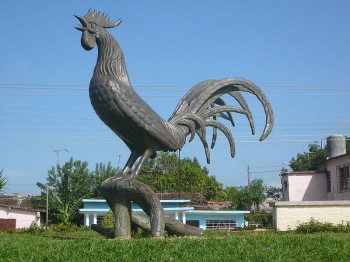The Rooster of Moron
Osmel Almaguer

The rooster is one of the most common creatures in Cuba. They exist in almost all houses and farms of the island’s countryside.
Within the world of the visual arts, this bird was the preferred theme of a 20th century Cuban painter: Mariano Rodriguez. In our national sport —baseball— the Sancti Spiritus team has the rooster as its mascot.
Perhaps the most famous rooster is that of Moron, whose symbol has become one of our national myths. Moron is a town in Ciego de Avila, a province in the center of the country.
This symbol came from a legend imported from Seville, Spain, where there is a town called Moron. In colonial times it was governed by a high-ranking official who was fairly abusive towards the locals. He often used phrases like: “There’s no one cockier than me,” and “Where this rooster crows, no other dares,” bragging of his authority and demonstrating his arrogance. Because of this, he became known as the “Rooster of Moron.”
It ended up that this boaster was lynched by his own victims, with that event giving rise to a ballad that was sung in all parts as a warning to other self-glorifiers: “Keep pushing your luck / you’ll be featherless with one cluck / like the rooster of Moron / when finally comes the dawn.
As a symbol of their scorn for him, the people of Moron erected a monument of a plucked rooster, which is a warning to those who mistreat people – a type of person that has always existed. From this, the residents passed down the tale of the “Rooster of Moron,” which is the symbol of that city today. (The name of this Cuban town is actually owed to Spaniard Don Ramon Moron, who sold his farmstead in 1525, though his name remained.)
But if the story of the “Rooster of Moron” is the most famous, that of the “Rooster of the Moro” is perhaps the most emblematic, because it embodies many of our traditions and witticisms, as well as the prankish nature of Cubans.
This legend was related to me by a friend from Ciego de Avila, who explained that in his town (which is not Moron) there was a Moor who practiced “brujeria,” an Afro-Cuban religion. The man used a rooster in rites and spells to solve many people’s problems (though perhaps the fowl was more the instrument of mass hoodwinking).
It turned out that the Moor had a friend who was the owner of the rooster. When the Moor practiced his spiritual craft, he told his paying believers that he needed a rooster to complete his “services.” He recommended they buy the one his friend owned, which was later returned to the owner and re-sold to the Moor countless times.
According to my friend, it seems that the Moor wound up like the “Rooster of Moron” (featherless and cackling) because he too was mistreating people – though in a different way.

A very interesting article, Senor. That is a beautiful sculpture as well. I shall have to find my way to Moron to see it next visit. I will not state the obvious, but perhaps there are one or two roosters yet to be plucked?